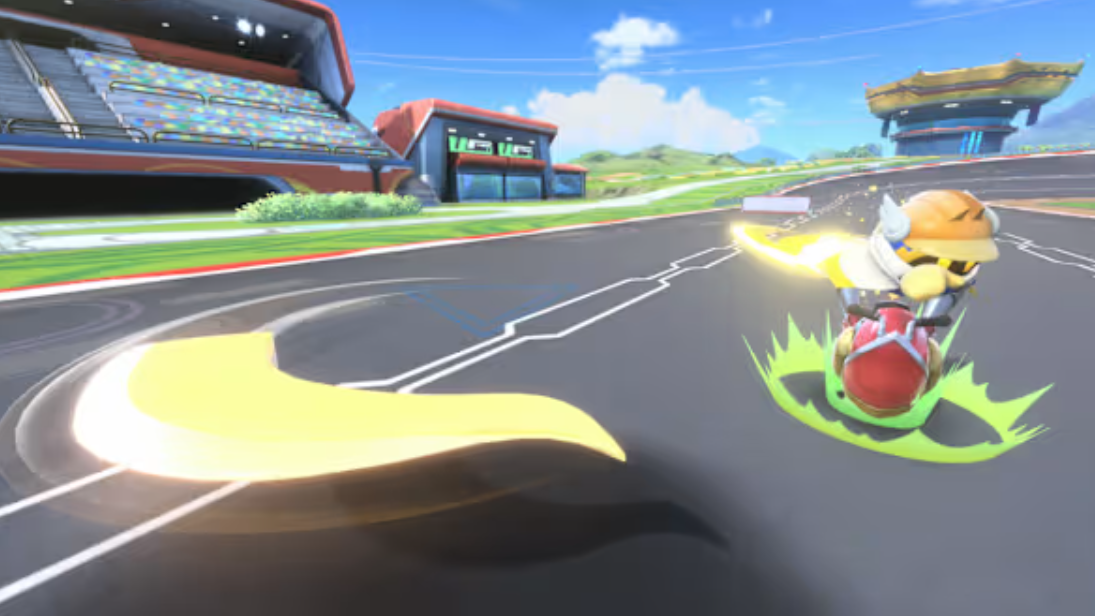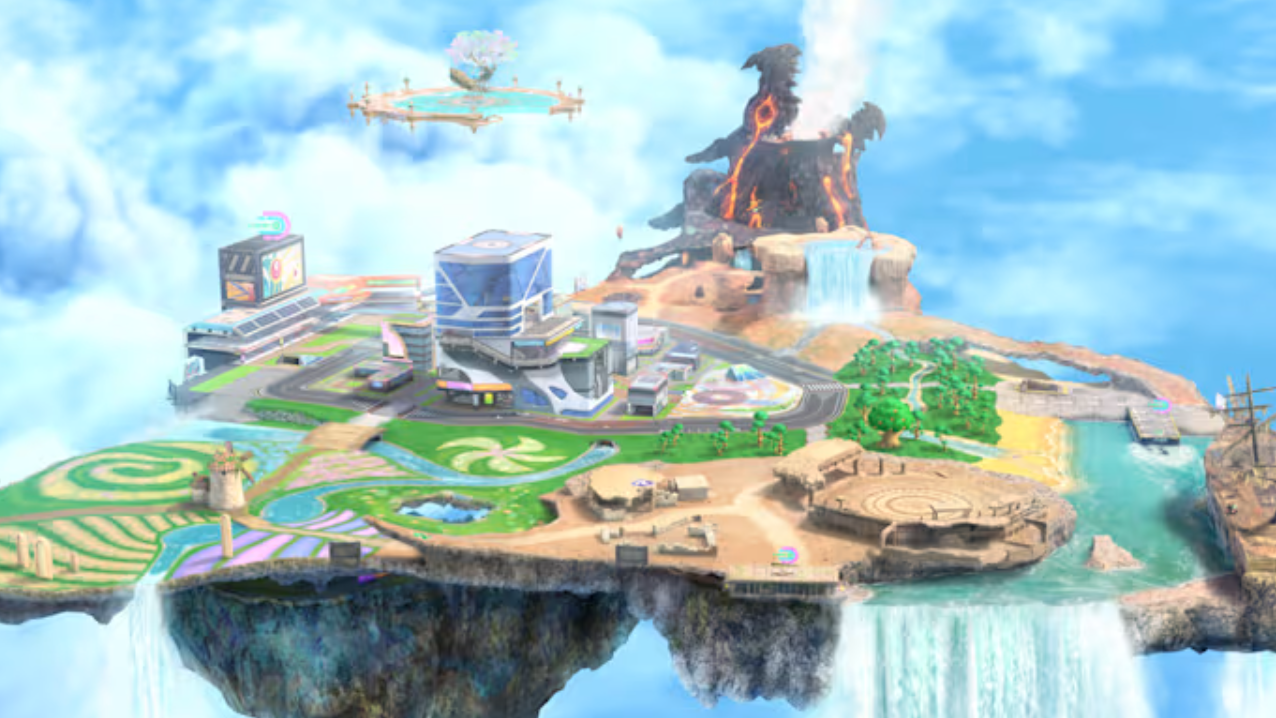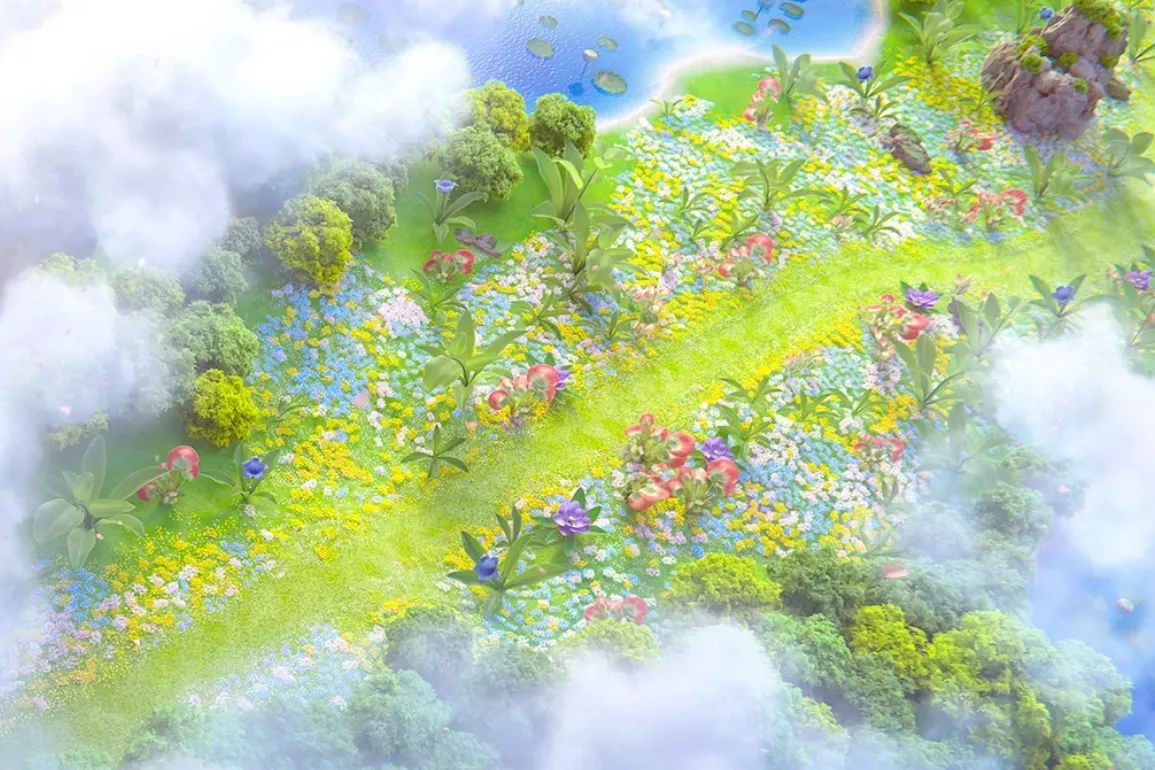City Trial in Kirby Air Riders is built around one clear loop: scramble for upgrades on the floating island of Skyah for five minutes, then take your tuned machine into a short Stadium contest. Everything else — the field events, legendary machines, and PvP — exists to push that loop into chaos.
How a full City Trial match flows
Every match follows the same basic structure:
| Phase | Approx. length | What you do | What carries over |
|---|---|---|---|
| Build phase on Skyah | 5 minutes | Collect power-ups, switch machines, fight rivals, react to field events | Your current machine, its HP, and all stat boosts |
| Stadium selection | Brief | One of four Stadium options is chosen at random for the room | Nothing new; it only sets the final objective |
| Stadium contest | Seconds to a couple of minutes | Compete using the machine you built | Results, checklist progress, ranks, and unlock progress |
You always start on Skyah with a basic machine and a clean stat line. When the five-minute timer hits zero, you are kicked straight into a Stadium with whatever you are driving at that exact moment, so the build phase is where the real decisions happen.

Skyah: the five‑minute build phase
Skyah is a floating island-city made up of distinct areas — a central urban block, underground sections, a volcano and crater, a shipwreck by the water, and high-altitude spots like the Hanging Garden and a Floating Island. Rails connect many of these zones for fast travel, and you can grind them to cut across the map quickly.
During the five-minute build phase, you are trying to do three things at once:
- Find and stay on a good machine
- Gather as many stat power-ups as possible
- Exploit events, bosses, and PvP to steal upgrades from other players
Machines, durability, and swapping
You begin on a weak starter machine (the Compact Star in the classic version of City Trial). On Skyah, stronger machines are parked or fly in as formations; you can jump off your current ride and claim a new one on the spot. During the Switch 2 build phase, if your machine is destroyed, you are dumped back onto the ground and must sprint to the nearest empty vehicle.
Machine choice in City Trial is less about raw lap times and more about how easily you can move through chaos:
| Machine type | Strengths in City Trial | Risks |
|---|---|---|
| Stable all‑rounders (Warp Star, Wagon Star, Chariot) | Easy to steer, good enough speed and HP for events and PvP | Won’t dominate highly specialized Stadiums without strong stats |
| High‑speed specialists (Formula Star, Turbo Star, wheel bikes) | Excellent for Drag Race and speed-focused Stadiums when well‑buffed | Weak acceleration or handling makes early patch gathering harder |
| Flight machines (Winged Star, Flight Warp Star) | Reach Hanging Garden, Floating Island, and excel in Air Glider / High Jump | Often fragile and poor on the ground; bad matchup for combat Stadiums |
| Combat‑heavy tanks (Rex Wheelie, Battle Chariot, Bull Tank) | High offense and durability for Dustup Derby, VS Boss, and crowded events | Usually slower and clumsier in pure races or precision targets |
| Legendary Machines (Dragoon, Hydra) | Top-tier stats that can trivialize many Stadiums once assembled | Require collecting three rare parts during the match; you become a target |
Durability matters because a destroyed machine drops a chunk of your collected power-ups for others to grab. Light, fragile rides like Winged Star or Shadow Star reward expert play and map knowledge but punish mistakes. Sturdy frames such as Wagon Star or Bulk Star give you time to stay in the fight and keep your build intact.
Near the end of the timer, you should reassess: if your machine’s stats don’t line up with any of the four Stadium candidates shown on the selection screen, it may be worth bailing to a different vehicle that synergizes better with the stats you did manage to collect.
Stat power‑ups and where to find them
Power-ups on Skyah look like floating patches or items. Each one raises or lowers a specific stat: Boost, Top Speed, Turn, Charge, Glide, Weight, Defense, or sometimes HP. A few raise all stats at once.
They appear in several ways:
- Loose on the ground in high‑value areas
- Inside destructible boxes
- Dropped by bosses, events, or rivals when their machines break
| Location or object | What you gain | Why go there |
|---|---|---|
| Cave near the arena | Patches hidden inside ore formations | Good early-game burst of items; ore does not respawn |
| Underground shopping mall | Clusters of boxes and items | Reliable midgame stop with multiple entrances and exits |
| Inside the volcanic crater | Dense boxes | Fast clearing if you have good attack; limited entrances |
| Hanging Garden (above the city) | Many loose patches, few containers | Ideal for characters with strong flight who lack raw attack |
| Floating Island (spawns outside the main ring) | Loose patches in high quantity | High‑risk, high‑reward; requires strong Glide or a flight‑oriented machine |
| Shipwreck near the water | Items that respawn on a short loop | Consistent refill stop during the mid to late build phase |
Boxes come in three colors with distinct roles:
- Blue boxes: mainly stat patches and food (healing). They are your bread‑and‑butter during the build phase.
- Green boxes: temporary-use items such as Invincibility Candy, Attack Up, or offensive tools like panic spins and bombs.
- Red boxes: Copy Abilities in most cases, but occasionally a part of a Legendary Machine like Dragoon or Hydra.
Quick Spin — wiggling the stick rapidly to spin your machine — cracks boxes instantly and can also steal loose patches from under an opponent’s nose. Some characters with auto‑attacking bodies or weapons can smash boxes simply by bumping into them.
Legendary Machines and shared parts
Dragoon and Hydra return as Legendary Machines that can be assembled during City Trial by collecting three distinct parts. These parts appear in red containers and during dedicated events. In team matches, Legendary Machine parts are shared by the team: whoever picks up the final piece gets to pilot the completed machine, but everyone benefits from protecting the player who already holds earlier parts.
Legendary Machines behave like extreme versions of normal rides: Dragoon focuses on glide and aerial control, making Air Glider, High Jump, and long-target Stadiums trivial if you can keep it intact; Hydra emphasizes raw speed, bulk, and destructive power for Drag Races and combat‑heavy Stadiums.
Events on Skyah and why they matter
During the build window, Skyah regularly throws out “Field Events” that temporarily change the rules or spawn special opportunities. Typically, only one or two significant events occur per match, so engaging with them is often more efficient than wandering the map alone.
| Event type | Examples | Impact on play |
|---|---|---|
| Boss fights | Dyna Blade, Grand Wheelie, Kracko | Drop large rings of patches and often All patches when damaged or defeated |
| First‑come, first‑served goals | UFO flyover, Reward Ring, Pillar spawn, Secret Chamber in Castle Hall | Reward the first players to reach or destroy the object with many upgrades or Copy Abilities |
| Machine modifiers | Amok Engine / Rowdy Charge Tank, Legendary Machine spawns | Temporarily push all machines out of control or make specific machines appear on the field |
| Box and item chaos | Rubbery Items, Same Item, Rare Box spawns | Make items bounce, unify box contents, or flood the map with high‑value containers |
| Hazards and visibility | Meteors, Gordos falling, Burning Rail Stations, Fog | Force players to take damage‑heavy routes or navigate with limited sight |
| Restoration and support | Lighthouse active, Restoration Areas | Offer zones where machines slowly repair HP over time |
| Minigame‑style | Short Race, Dustup Derby events inside Skyah | Provide extra patches based on placement even before the final Stadium |
One recurring event features Tac, a thief carrying a bag of power-ups. Chasing and ramming him repeatedly across the map causes him to drop patches; stealing several items from him is tracked in City Trial’s checklist.
Other events subtly test your pattern recognition. During Fake Power-Ups, some patches are visual fakes that lower a stat and damage your machine instead of boosting it. The icons change slightly — tilted arrows, hollow shapes, missing details — so you can avoid them if you pay close attention in the middle of the scramble.
Characters, auto‑attacks, and specials
Characters in Kirby Air Riders are not just skins; they bring their own stats, attack hitboxes, and special moves that change how you operate during City Trial. Two traits matter most:
- Whether your rider auto‑attacks on contact, making box breaking and bullying rivals easier
- What their special move does — speed, attack, flight, or hybrid effects
| Rider example | Key strengths in City Trial | Best Stadium pairings |
|---|---|---|
| Rick | High top speed, strong attack and durability, tight turning and grip | Versatile across Drag Race, Dustup Derby, and mixed challenges like Gourmet Race |
| Meta Knight | Auto‑attacking melee, strong specials that combine speed and offense | Dustup Derby, Kirby Melee, speed Stadiums where he can cut through crowds |
| Knuckle Joe | Forward‑focused melee and strong offensive specials | Combat events on Skyah, Dustup Derby, VS Boss Stadiums |
| Star Man, Marx, Daroach and similar S‑tier picks | Mobility and specials that dramatically change flight or area control | Air Glider, High Jump, Target Flight, and patch‑dense aerial zones like Hanging Garden |
Auto‑attacking riders shine in City Trial because they simplify a lot of micro‑inputs: instead of constantly Quick Spinning, you can body‑check boxes and enemies while focusing on routing and event timing. That is especially valuable during online matches with 16 riders, where fights over a single red box or boss drop can turn into pileups in seconds.
Items and how they scale with stats
Beyond permanent patches, temporary items are a second layer of City Trial’s power economy. You obtain most of them from green boxes and use them immediately on pickup. Two broad classes matter:
- Gathering tools such as the Item Catcher, which creates a circular field in front of your machine that pulls in any loose items inside it
- Offensive tools such as Fire Cracker, Laser Wiper, Multi-Missile, Scale Up, and Mega Cannon
Offensive items scale with your attack stat. A rider or machine with high offense turns these into real kill tools instead of light harassment. That interaction creates a feedback loop: build attack, win events and PvP fights with fewer hits, and claim the dropped patches from those wins.
Defensively, healing food like Apples, Energy Drinks, Hamburgers, Sushi, and Maxim Tomatoes restore fixed amounts or full HP. Restoration Areas and the Lighthouse’s beam offer slower, area‑based healing if you are willing to give up some time in exchange for keeping your machine and patches intact.

Stadium challenges and what your build is tested on
Once the five‑minute timer ends, your squad of machines is dropped into a randomly chosen Stadium from a set of four that were previewed on the build‑phase UI. You cannot change vehicles or stats at this point; the Stadium simply asks, “Did you build for this?”
| Stadium | Core objective | Key stats and machine traits |
|---|---|---|
| Drag Race | Blast straight down a short course as fast as possible | Top Speed, Boost, Weight (for stability on hits); wheel‑based machines excel |
| Air Glider | Launch from a ramp and glide as far as you can | Glide, Top Speed, light Weight; flight machines and Dragoon dominate |
| Target Flight | Slide down a slope and aim for score panels on a target board | Fine control in the air, Glide, Turn; heavy wheels struggle |
| Kirby Melee | Defeat as many enemies as possible in an arena | Offense, HP, strong Copy Abilities, and riders with good melee specials |
| Dustup Derby | Destroy as many rival machines as you can within the time limit | Offense, Defense, HP; durable combat machines and attack‑oriented riders |
| Skydive | Drop while boosting and aim for a high landing score | Boost control, Glide, handling in vertical movement |
| Gourmet Race | Collect as much food as possible on a short course | Turn, acceleration, and routing knowledge; balanced speed machines fare well |
| High Jump (classic set) | Reach maximum airtime height off a single ramp | Glide and Boost more than raw Top Speed |
| Single Race / Oval Circuit / Beam Passage, etc. | Standard one‑lap or looped races | Top Speed, acceleration, and dependable cornering |
Some Stadiums, like Drag Race or Air Glider, are brutally specialized; if you show up on a slow tank covered in Defense patches, you are mostly along for the ride. Others, like Kirby Melee, Target Flight, Gourmet Race, and newer contests such as Switch Frenzy, keep multiple playstyles viable as long as your build has at least one clear strength.
Online, the lobby picks from four Stadium options, which means you almost always see at least one event your current machine can succeed in. The strategic layer is less about “winning every Stadium” and more about pivoting your build mid‑match so that at least one likely outcome plays to your strengths.
City Trial works because it never really slows down. Skyah’s five‑minute build phase throws enough items, events, and PvP collisions at you that you barely have time to process what your machine is becoming before the Stadium spotlight turns on. Once you understand that rhythm — improvise a build, lean into whatever Skyah gives you, and accept that the final contest might be over in 15 seconds — the mode stops feeling like noise and starts feeling like a tightly wound arcade machine that resets every round.


